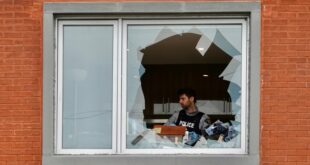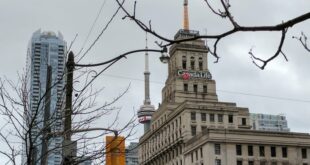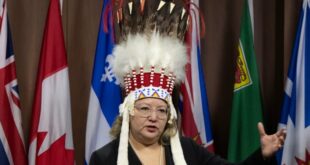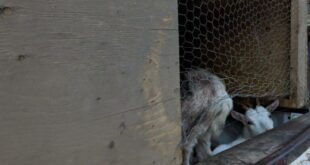Preferred site, in either southern or northwestern Ontario, to be chosen by year’s end.
The body tasked with selecting the future storage site for Canada’s nuclear waste has reaffirmed its confidence in the project’s safety, but others remain concerned about the potential risks of burying spent nuclear fuel hundreds of metres below the earth’s surface.
By the end of this year, the Nuclear Waste Management Organization (NWMO) is expected to decide on its preferred site for the country’s first deep geological repository for used nuclear fuel.
The potential locations are:
- The Wabigoon Lake Ojibway Nation-Ignace area, about 250 kilometres northwest of Thunder Bay.
- The Saugeen Ojibway Nation-South Bruce area in southern Ontario, about 130 kilometres northwest of London.
Earlier this month, the NWMO released updated “Confidence in Safety” reports, which say both sites are suitable for the safe, long-term storage of spent nuclear fuel.
However, We the Nuclear Free North and the First Nations Land Defence Alliance, for example, remain concerned about what’s known as the Revell site in northwestern Ontario.
The alliance issued a letter to NWMO president and CEO Laurie Swami on March 5, saying: “Our Nations have not been consulted, we have not given our consent, and we stand together in saying ‘no’ to the proposed nuclear waste storage site near Ignace. We call on you to respect our decision.”
‘They’re both good sites’: NWMO
Paul Gierszewski is a technical subject matter expert with the NWMO and lead author of the “Confidence in Safety” reports, which build on previous reports but include more details around geology, design and safety assessment.
While the Revell site is composed of crystalline rock and the South Bruce site of sedimentary rock, “they both meet our criteria for that stability, durability, hydraulic barrier, suitable chemistry.”
“They’re both good sites. We think that both of the sites would be safe,” Gierszewski said.

Brennain Lloyd is project co-ordinator with Northwatch, which is part of We the Nuclear Free North. Members of the organization feel less confident about the project’s safety, she said.
“I think this newest report from the NWMO tries to put the best face possible on a project which is absolutely loaded with risk and uncertainty, and uses a lot of language that’s difficult for the public, for non-technical leaders to work through,” Lloyd said.
“There are no resources available in any part of this process for the public to be able to get technical assistance from independent third-party peer reviewers.”
WhileGierszewski says the 2023 reports expand on the previous year’s findings, Lloyd questions whether they contain new information or airbrushed statements that “paint a better picture.”
Gierszewski said more detailed assessments will be done once the preferred site is chosen.
“When you’ve got a focused community, you can have more discussion with the people now because there’s kind of focus on that community and their interests,” he said.
Demand for in-person meetings
Chief Rudy Turtle of Grassy Narrows First Nation, 250 kilometres northwest of Ignace, said no one from the NWMO has met with him in person to discuss the proposed nuclear waste site.
Grassy Narrows has a particular interest in which Ontario site is chose, given the First Nation’s experiences dealing with contaminated fish in the 1960s and ’70s. Mercury from a Dryden pulp and paper mill was dumped into the English Wabigoon River, upstream from the First Nation. Research indicates past mercury exposure continues to impact the health of people in the community.

In the case of a nuclear waste repository, Turtle said, “Should there be any leak or if the containment fails, there is the possibility that [toxic chemicals] can leak downriver again.”
Turtle would like to see a series of in-person meetings so people can better understand the safety measures being proposed and the potential risks.
Consultation comes later, says NWMO
Joe Heil is the NWMO’s director of Indigenous engagement for the northwest and a member of Oneida Nation of the Thames.
Heil said there’s an important distinction between community engagement, which is what the NWMO is doing now, and the duty to consult, which is triggered once the site is selected and the regulatory process begins.
“That’s really where the other surrounding voices — both Indigenous and non-Indigenous — come into that process through the impact assessment.”
Heil is aware of the letter sent by the First Nations Land Defence Alliance, and said he is “absolutely” willing to meet with members in person to share information about the project.

“Most communities’ starting position is no … but as [they] learn about the project and that we believe it can be done safely, extremely safely — people tend to change their views on that.”
Chief Michele Solomon of Fort William First Nation said it is unlikely her community’s position against the site will change.
Band council passed a resolution last September calling for the Ontario government to adopt the proximity principle, which means nuclear waste would be stored at the point of generation and not transported elsewhere.
“Anything that has the potential to get into our waterway that would cause harm to the fish or to the animals or to our people … we take that very seriously,” Solomon said.
An NWMO representative has reached out to Fort William, but it’s up to band council to decide whether to meet with them, she said.
“I don’t know that the NWMO can alleviate the concerns.”
‘Learning on both sides’
Clayton Wetelainen is chief of Wabigoon Lake Ojibway First Nation, a community of about 200 people 20 minutes east of Dryden. He was among a delegation sent to Finland last summer to tour the world’s first long-term nuclear waste repository. The NWMO paid for the trip.
The NWMO has provided funding to support nuclear education in Wabigoon Lake. The First Nation also has third-party reviewers go over technical documents from the NWMO and help the community better understand the project, Wetelainen said.

At this point, he said, the consensus of the community is “mixed,” though over the years, more members have become receptive to the idea of hosting the repository.
During the Finland trip, members of Wabigoon Lake were encouraged to take their time in making decisions about their willingness to be a host community, “and we took that to heart.”
From his perspective, the NWMO has been making substantial efforts to engage with the potential hosts, he said.
“I think they’re learning from both communities, they’re learning what a First Nation requires to make a decision — and I think it is learning on both sides.”
ABOUT THE AUTHOR

Reporter
Sarah Law is a CBC News reporter based in Thunder Bay, Ont., and has also worked for newspapers and online publications elsewhere in the province. Have a story tip? You can reach her at sarah.law@cbc.ca
*****
Credit belongs to : www.cbc.ca
 Atin Ito First Filipino Community Newspaper in Ontario
Atin Ito First Filipino Community Newspaper in Ontario






